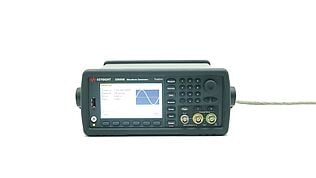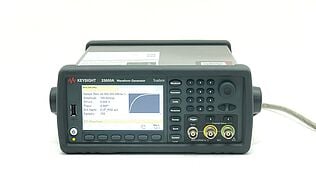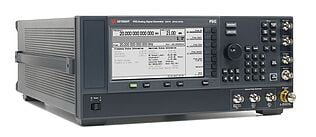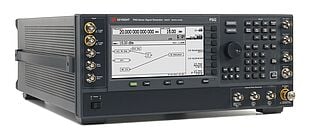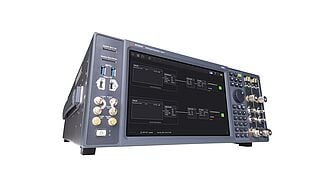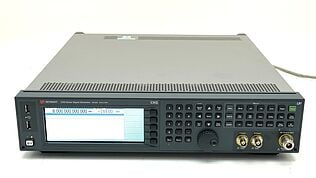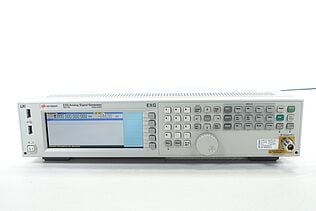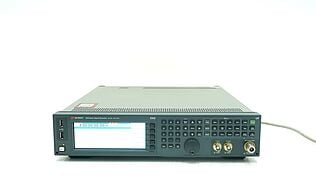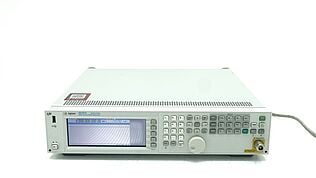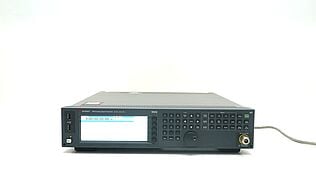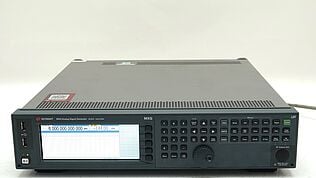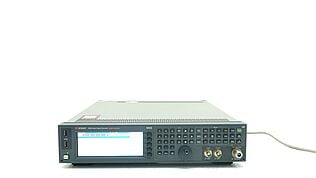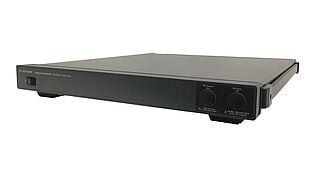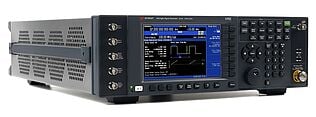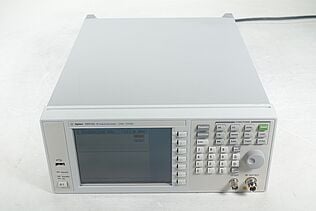- Buy used signal generators to finish your project on time
- Buy used signal generators with faster delivery times
- Introduction
- What Is a Signal Generator?
- Common Waveforms Produced by Signal Generators
- Network Analyzer vs. Oscilloscope vs. Signal Generator
- What Do You Use a Signal Generator For?
- What Features To Look For in a Signal Generator
- Waveforms and Modulations
- Frequency Range
- Frequency Resolution
- Sampling Rate
- Phase Lock Mode
- Output Impedance
- Types of Signal Generators
- Arbitrary Waveform Generator
- Vector Signal Generator
- Pulse Generator
- Radio Frequency Signal Generator
- Audio Frequency Signal Generator
- Video Signal Generator
- Buy a Premium Refurbished Keysight Signal Generator And Get it Shipped Fast/With 2 Weeks Shipping
- Did You Know?
- Closing Thoughts From Keysight
- Whenever You’re Ready, Here Are 4 Ways We Can Help You
- Buy used signal generators from Keysight for peace of mind
- FAQ
When it comes to choosing a signal generator, engineers face several challenges. One of the biggest issues is that there are many different signal generators on the market and it can be challenging to determine which one is suitable for the job.
Factors to keep in mind when deciding to buy:
- Power requirements
- Frequency range
- Sampling rate
- Output impedance
In this buying guide, we will discuss frequently asked questions and provide information to help you select the perfect signal generator.
What Is a Signal Generator?
A signal generator is an electronic device that generates signals of specific electrical waveforms. Signal generators are used to design, test, and manufacture systems and individual components. Depending on the application, these waveforms can be either repetitive or single-shot (one-time).
The most basic signal generators produce sine waves, square waves, and triangular waves. More advanced units can generate more complex waveforms, such as sawtooth waves and pulses.
Some signal generators also include features like frequency modulation and amplitude modulation. In general, signal generators are used to create test signals for electronic circuits or devices and are essential equipment for electronic engineers and technicians.
Buy used signal generators with faster delivery times
Common Waveforms Produced by Signal Generators
| Waveform | Description |
|---|---|
| Sine Wave | Characterized by its smooth, periodic shape. Due to their simple shape, sine waves are used extensively in signal processing and communication systems. Sine waves can be combined to create more complex waveforms to carry information. A sine wave's amplitude, frequency, and phase can be manipulated to encode information in a signal. |
| Square Wave | A square wave waveform is an electrical signal that alternates between two states, represented by a high voltage and a low voltage. However, they can also be represented by high currents and low currents. The transition between the two states is always abrupt, which gives the waveform its name. Square wave waveforms are often used to generate digital signals since electronic circuits can easily process them. |
| Triangle Wave | A waveform that alternates between two values at a constant rate, resulting in a triangular shape when graphed. The waveform rises or lowers until it reaches a certain value and then lowers or rises again, respectively. The most common form of a triangle wave has an amplitude that alternates between positive and negative values. Triangular waves can also have non-zero DC offsets. |
Network Analyzer vs. Oscilloscope vs. Signal Generator
Signal generators are often confused with similar devices, such as oscilloscopes and network analyzers. Understanding the differences is important, as they each serve a unique purpose.
| Network Analyzers | Oscilloscopes | Signal Generators |
|---|---|---|
| Measures the performance of an electronic device by analyzing its frequency response | Measures the voltage of an electronic signal as it varies over time | Generates signals in electrical waveforms |
| Better suited for observing the behavior of steady-state signals | Better suited for monitoring the behavior of transient signals | Used to create test signals for electronic circuits |
| Typically require more setup time and expertise to use effectively | Inexperienced users may find oscilloscopes to be more user-friendly | Can produce simple or complex waveforms or can be modulated to convey information |


Both oscilloscopes and network analyzers can be used to measure and analyze signals, but only a signal generator can generate signals. Both network analyzers and oscilloscopes have their strengths and weaknesses, and the best instrument choice depends on the user's specific needs.
What Do You Use a Signal Generator For?
As is suggested in the name, the primary use of a signal generator is to generate signals. These signals can be used for various purposes:
- Designing and testing new circuits
- Troubleshooting existing circuits
- Calibrating instruments
- Generating audio or RF signals
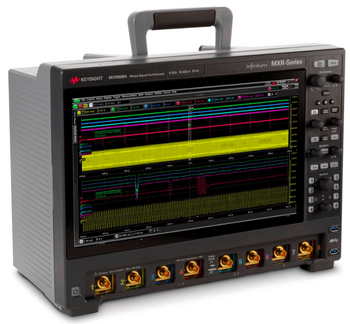
Depending on the application, they can also produce repeating or non-repeating waveforms, which is useful for testing as different waveforms can help identify other problems.
What Features To Look For in a Signal Generator
A signal generator is an essential piece of equipment for any engineer. When choosing a signal generator, there are several important factors to consider, such as frequency range, distortion, and broadband noise.
- Frequency range is one of the most important specifications, as it determines the range of signals that the generator can produce. For example, a signal generator with a frequency range of 1 MHz to 1 GHz would be suitable for testing digital circuits, while a signal generator with a frequency range of 10 MHz to 20 GHz would be better suited for testing RF circuits.
- Distortion. This adds unwanted frequencies to the signal. Ideally you would want a signal generator that produces minimal distortion.
- Noise. This creates random fluctuations in the signal and can affect the performance of the signal generator.
Distortion and noise degrade the performance of the circuit under test. Therefore, choosing a signal generator with low distortion and low noise levels is important.
Waveforms and Modulations
When selecting a signal generator, one thing you will need to keep in mind is the type of waveform you need. Signal generators are often classified by the type of waveform they produce, such as sinusoidal, triangular, square, arbitrary, and so on.
The waveform of a signal generator can be modified through modulation techniques. Modulation is the process of varying a signal to convey information.
Common modulation types include amplitude modulation (AM), frequency modulation (FM), and phase modulation (PM). You can achieve different effects by varying the depth and rate of the modulation. More complex sounds can be produced by combining different modulation types.
Many kinds of signal modulation are available, so it is important to understand which one you need before purchasing. With a bit of research, you should be able to find a signal generator that meets your specific needs.
Frequency Range
Another consideration is the frequency range. The frequency range is the range of frequencies the signal generator can produce. The frequency range is typically specified in terms of the minimum and maximum frequencies.
For example, a signal generator with a frequency range of 1 kHz to 1 GHz can generate signals with frequencies ranging from one thousand hertz to one billion hertz. The broader the frequency range, the more versatile the signal generator will be. The narrower the frequency range, the higher the quality of the produced signals.
In general, you should choose a signal generator with a frequency range appropriate for the types of signals you need to generate.
Frequency Resolution
Frequency resolution refers to the smallest steps the device can make when changing frequencies. For many applications, a signal generator with good frequency resolution is essential.
For example, when testing digital devices, it is often necessary to generate signals with exact frequencies. If a signal generator has a frequency resolution of 1 Hz, it can generate signals with frequencies that differ by only 1 Hz.
When choosing a signal generator, carefully consider the desired frequency resolution. Otherwise, you may be unable to create the signals you need for your application.
Sampling Rate
As its name suggests, the sampling rate is the speed at which a signal generator takes samples of an input signal. A high sampling rate is essential for many applications to accurately capture brief pulses or transients.
However, a lower sampling rate may be sufficient for other applications where the input signal is relatively steady.
As a general rule of thumb, it’s always better to err on the side of caution and choose a signal generator with a higher sampling rate than you think you need. After all, you can always dial down the sampling rate if it’s not required, but you can’t increase it if your signal generator doesn’t have the capability.
Keysight has an excellent range of signal generators with high-speed sampling rates. Check out our range of premium signal generators at a discounted rate.
Phase Lock Mode
This mode allows the generator to lock onto an external reference signal, ensuring that the output remains in sync with the reference. This mode allows the signal generator to lock onto a specific frequency and phase. This can be useful when testing equipment operating at a specific frequency, such as cellular phones.
Phase lock mode ensures the signal generator stays at the correct frequency, even if the tested equipment's load changes. As a result, phase lock mode can help to ensure accurate test results.
Phase lock mode also helps to reduce interference between multiple generators, making it ideal for use in multi-unit setups. With so many benefits, phase lock mode has become a must-have feature for many engineers using signal generators.
Output Impedance
Another key feature to look for is the output impedance. Output impedance measures how well the signal generator can match the load (usually, this is the impedance of the device under test).
A high output impedance will result in a loss of power, while a low output impedance will increase distortion. The best signal generators have an output impedance that can be adjusted to match the load impedance of the device under test. This allows for optimum performance and prevents damage to the device under test.
When choosing a signal generator, be sure to check the specs to see what the output impedance is. This will help you to ensure that you're getting a product that will work well for your needs.
Buy used signal generators to finish your project on time
Select up to 3 instruments to compare
Enable Notifications
In order to use this feature, you need to enable notifications.
Manage notification preferences
Types of Signal Generators
When buying a signal generator, one of the first things you need to determine is what type of signal generator is suitable for the job.
There are a few different types of signal generators, each with unique features and benefits. Choosing the correct one will depend on the specific application and the features you require.
Arbitrary Waveform Generator
An arbitrary waveform generator is a device that generates electrical signals with any desired waveform. These signals can be used to test electronic components or to simulate real-world situations. For example, you can use an arbitrary waveform generator to create a signal that mimics a heartbeat.

A real-world application of this signal generator would be testing a medical device that detects heartbeats. Arbitrary Waveform Generators are also used in other research laboratories. They are used to create complex signals that are difficult to generate with other types of equipment.
One of the main advantages of using an AWG is that it can generate virtually any waveform. However, they can be expensive, as they are often used for complex applications.
If you need to generate a complex waveform, then an AWG is the right choice. However, if you only need to generate simple waveforms, another signal generator would be more suitable.
Vector Signal Generator
A vector signal generator is a type of RF signal generator that produces waveforms with precise timing relationships between the various frequency components. They are used in multiple applications, such as telecommunications, automotive testing, and aerospace.
Vector signal generators are capable of:
- Creating signals with very low distortion, making them ideal for use in sensitive applications
- Generating signals with a wide bandwidth, making them suitable for testing high-speed digital signals
- Generating extremely stable signals, making them ideal for use in calibration and test systems

These digital signal generators are often sensitive to environmental conditions, such as temperature and humidity. As a result, they must be carefully calibrated and maintained to produce accurate results.
Despite these challenges, VSGs are a powerful tool for any engineer working on wireless projects. Keysight has some of the most powerful vector signal generators on the market!
See our full range of premium refurbished vector signal generators at a fraction of the cost on our Used Equipment page.
Pulse Generator
A pulse generator is a type of electronic equipment that produces electrical pulses. Depending on the application, these pulses can be of various shapes, sizes, and durations. Pulse generators are used in a wide range of industries and have many different applications.
For example, they can be used to test:
- Electronic equipment
- Medical devices such as pacemakers and defibrillators
- Simulate physical phenomena such as seismic activity

Regardless of the specific application, pulse generators play an important role in many industries and technologies. However, keep in mind that if the pulse generator is not calibrated correctly, it can result in inaccurate readings. This can be a problem when trying to get precise results, such as in medical diagnosis or industrial experimentation.
Radio Frequency Signal Generator
A radio frequency signal generator is a device that creates RF (radio frequency) signals. These signals are used for various purposes, including testing and troubleshooting electronic equipment in cellular or satellite communications.

RF signal generators are also used in commercial settings to test cell phone reception or tune radios. Generally, RF signal generators cover a wide range of frequencies, from low-frequency AM signals to high-frequency microwave signals. As a result, they are versatile tools that are used for various applications.
One of the main advantages of RF signal generators is that they can generate signals at a wide range of frequencies. However, at high frequencies, phase noise can be an issue. This can be alleviated using a low-noise amplifier.
Audio Frequency Signal Generator
An audio frequency signal generator, also known as an AF signal generator, is a type of electronic test equipment that generates alternating current (AC) of variable frequency within the audio frequency range. Audio frequency signal generators are used in audio applications, such as amplifiers and sound systems, to adjust and test the frequency response of the devices.
AF Signal Generators are also used in radiofrequency (RF) and microwave electronics, such as RF power amplifiers and filters, to generate signals for measuring the gain and bandwidth of these devices. In addition, audio signal generators can be used to create sound bursts for testing or analysis purposes, ie, when troubleshooting audio equipment or analyzing acoustic materials.
An advantage of audio frequency signal generators is that they allow for precise frequency control, meaning you can create signals of exact frequencies, which can be very helpful for testing and calibrating purposes.
Audio frequency signal generators can be complex, so you may need training or experience to use one effectively.
Video Signal Generator
A video signal generator is a device that creates a video signal. The most common type of video signal generator is a synchronization pulse generator, which creates the horizontal and vertical synchronization pulses needed to produce a stable image on a screen.
Other types of video signal generators include color bar generators and test pattern generators. Color bar generators generate a series of color bars that are used to adjust the settings on a video display. Test pattern generators, create patterns of squares or other shapes used to test the performance of a video display.
Video signal generators are used in various applications such as
- Television broadcasts
- Film production
- Computer graphics
A video signal generator is an excellent tool for testing video equipment; however, there are a few things to keep in mind when using it.
Ensure that the video signal is compatible with your equipment; otherwise, you may not be able to get an accurate reading.
The video signal generator must be properly calibrated to provide accurate results. If it’s not calibrated, you might end up with distorted or inaccurate image quality.
Video signal generators can generate a lot of heat, so use them in well-ventilated areas and take precautions against overheating.
Keeping these challenges in mind ensures you get the most out of your video signal generator.
Buy a Premium Refurbished Keysight Signal Generator And Get it Shipped Fast/With 2 Weeks Shipping
As any engineer knows, a signal generator is an essential piece of equipment used to create signals of all shapes and sizes, making it an essential tool for testing and debugging circuits.
At Keysight, we are one of the leading manufacturers of signal generators. Our products are known for their quality and reliability.
Right now, we are offering a special deal on refurbished premium signal generators. This is a great opportunity to get your hands on a top-of-the-line instrument at a very reasonable price. So don't wait – head on over to our used equipment page and buy a premium signal generator today!
Did You Know?
Keysight is the only company that can provide calibration. When you buy from our Used Equipment page, you can rest easy knowing that your signal generator has been thoroughly tested and calibrated, meaning you can get straight to work and have confidence that you are using a reliable piece of equipment.
No other reseller can provide that guarantee. That’s why choosing Keysight for refurbished products is always the smartest choice.
While other resellers’ shipping times vary from 8-21 weeks, we guarantee for certain offers that your keysight used piece of equipment will reach your lab within two weeks*. Keysight Premium Used models are customizable, therefore the shipping process may be slightly longer. Browse our keysight signal generator offers and request a quote to speak to a sales agent today.
(* Two weeks shipping time offer available for US customers only. Dependent on item availability and location.)
Closing Thoughts From Keysight
As we have looked at in this article, a signal generator is a handy tool used for various purposes. When choosing a signal generator, there are several factors to keep in mind, such as frequency range, output power, and modulation capabilities.
Keysight's reliable signal generators offer a variety of features and capabilities, making them some of the best on the market. Whether you need a basic unit for simple tasks or an advanced model for sophisticated applications, our team of experts can help you find the perfect signal generator.
See Keysights Used Equipment to find the widest selection of discounted, high-quality signal generators to fit your needs.
Whenever You’re Ready, Here Are 4 Ways We Can Help You
- Browse our premium refurbished signal generators
- Call tech support US: 1 800 829-4444
Press #, then 2. Hours: 7am – 5pm MT, Mon– Fri - Talk to our sales support team by clicking the icon (bottom right corner) on every offer page
- Talk to your account manager for custom deals

Subscribe to Get Our Latest News, Updates, and Articles.
Buy used signal generators from Keysight for peace of mind
Select up to 3 instruments to compare
Enable Notifications
In order to use this feature, you need to enable notifications.
Manage notification preferences
FAQ
What is a signal generator?
A signal generator is a device that produces electrical signals of various types. Signal generators are used in many applications, such as testing electronics, generating tones for sound systems, and creating test signals with specific characteristics.
What are the advantages of signal generators?
Signal generators offer many benefits, such as the ability to create signals of all shapes and sizes, reduce interference between multiple generators, and adjust the output impedance to match the load impedance of the device under test.
What is the range of a signal generator?
The frequency range of a signal generator is the range of frequencies that the device can generate. Most inexpensive units only cover a small portion of the radio spectrum, while more expensive models offer broader coverage.
Are signal generators DC or AC?
Signal generators can generate both DC and AC signals. DC signals are used for low-frequency applications such as audio, while AC signals are used for high-frequency applications such as radio.
